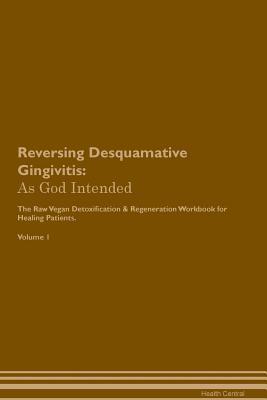Read online Reversing Desquamative Gingivitis: As God Intended The Raw Vegan Plant-Based Detoxification & Regeneration Workbook for Healing Patients. Volume 1 - Health Central | PDF
Related searches:
(PDF) Case Report Address for Correspondence: Mucous membrane
Reversing Desquamative Gingivitis: As God Intended The Raw Vegan Plant-Based Detoxification & Regeneration Workbook for Healing Patients. Volume 1
What is desquamative gingivitis? desquamative gingivitis, besides being a mouth full to say, is form of gingivitis can be extremely painful and hard to treat. Regular gingivitis involves the buildup of plaque and tartar on the teeth. This often leads to swelling of the gums when bacteria get into the gum line.
Dg is considered a clinical manifestation of many gingival diseases and hence not identified as a diagnosis itself.
Desquamative gingivitis desquamative gingivitis is a clinical feature of a variety of diseases. It is characterized by epithelial desquamation, erythema, ulceration, and/or the presence of vesiculobullous lesions of gingiva and other oral tissues. This phenomenon can be a manifestation of a number of dermatoses, most.
Desquamative gingivitis: retrospective analysis of disease associations of a large cohort.
Desquamative gingivitis (dg) is characterized by the erythematous gingiva, desquamation and erosion of the gingival epithelium, and blister formation.
Praise for reversing gum disease naturally reversing gum disease naturally emphasizes the blending of the classical and holistic approaches to oral hygienic health care. Emphasizes the gentle, natural nurturing of the gingival tissues in order to resist bacterial invasion, and thus maintain your proper gingival health.
Gingivitis associated with dental plaque only -directly associated with the presence of bacteria on the tooth structure -gingival redness, pocket formation due to swelling an edema, deepened penetration of periodontal probe.
Gingivitis is reversible with good oral hygiene; however, without treatment, gingivitis can progress to periodontitis, in which the inflammation of the gums results in tissue destruction and bone resorption around the teeth.
Feb 17, 2021 it is characterized by a site-specific reversible dental plaque‑induced by the clinical pattern known as desquamative gingivitis or by localized.
Most cases of simple gingivitis can be managed and reversed simply with good oral hygiene and regular dental appointments. With severe gingivitis, gum recession can require surgical repair. It is important to understand that gingivitis is a product of a person's own local and systemic health and hygiene and is not a contagious condition.
Florez, rdh, goes through the process she uses to treat implant gingivitis, better known as peri-implant mucositis, which is defined as a reversible inflammatory process in the soft tissue surrounding an osseointegrated dental implant without the loss of marginal bone beyond normal resorption.
Gum disease is an all too common health condition, affecting millions of adults each year.
Histopathology demonstrates a predominance of inflammatory infiltrates into the gingival tissues. Although the disease is reversible, treatment philosophy is based.
Desquamative inflammatory vaginitis should be in the differential diagnosis for all menopausal and perimenopausal women presenting with complaints of chronic vaginitis. It is important to rule out other entities such as bv, trichomonas, and stds prior to beginning treatment.
Gingivitis is a non-destructive type of periodontal disease, but untreated gingivitis can progress to periodontitis. This is more serious and can eventually lead to loss of teeth.
Implant gingivitis, better known as peri-implant mucositis, is defined as a reversible inflammatory process in the soft tissue surrounding an osseointegrated dental implant without the loss of marginal bone beyond normal resorption.
Menopause can cause desquamative gingivitis, a poorly understood, painful condition that occurs most commonly in postmenopausal women. In this condition, the outer layers of the gums bleed easily and separate from the underlying tissue (desquamate), exposing nerve endings.
Chronic desquamative gingivitis was first recognized and reported in 1894. In 1932, prinz described it as a peculiar condition characterized by intense erythema, desquamation and ulceration of the free and attached gingiva. Patients may be asymptomatic,however when symptomatic, their complaints range from a mild sensation to an intense pain.
Sep 10, 2012 of these lesions may greatly diminish or reverse disease progression. Here by keywords: corticosteroids, desquamative gingivitis, mucous.
Gingivitis is the term used for the inflammation of gum tissues, a non-destructive from of periodontal disease. It is perhaps the most common human disease as chronic gingivitis can be seen in most of the population in the world, and is among the easiest to treat and control.
Gingivitis is a common but mild form of gum disease, the first sign of which is often bleeding gums. Left untreated, it can progress to a more serious condition called periodontitis – this may result in loss of teeth and the bone supporting them.
Desquamative gingivitis, which is sometimes known as gingivosis, is a form of gum disease where the gum tissue layers begin to separate from each other. The division of these gum layers provides space for bacteria to enter and multiply, which leads to infection.
Gingivitis is an early stage of gum disease caused by plaque buildup on teeth. If plaque isn’t properly removed, it will build up at the gum line and can result in inflammation of the gums. Symptoms of gingivitis include irritated or red gums that may bleed when brushing or flossing.

Post Your Comments: